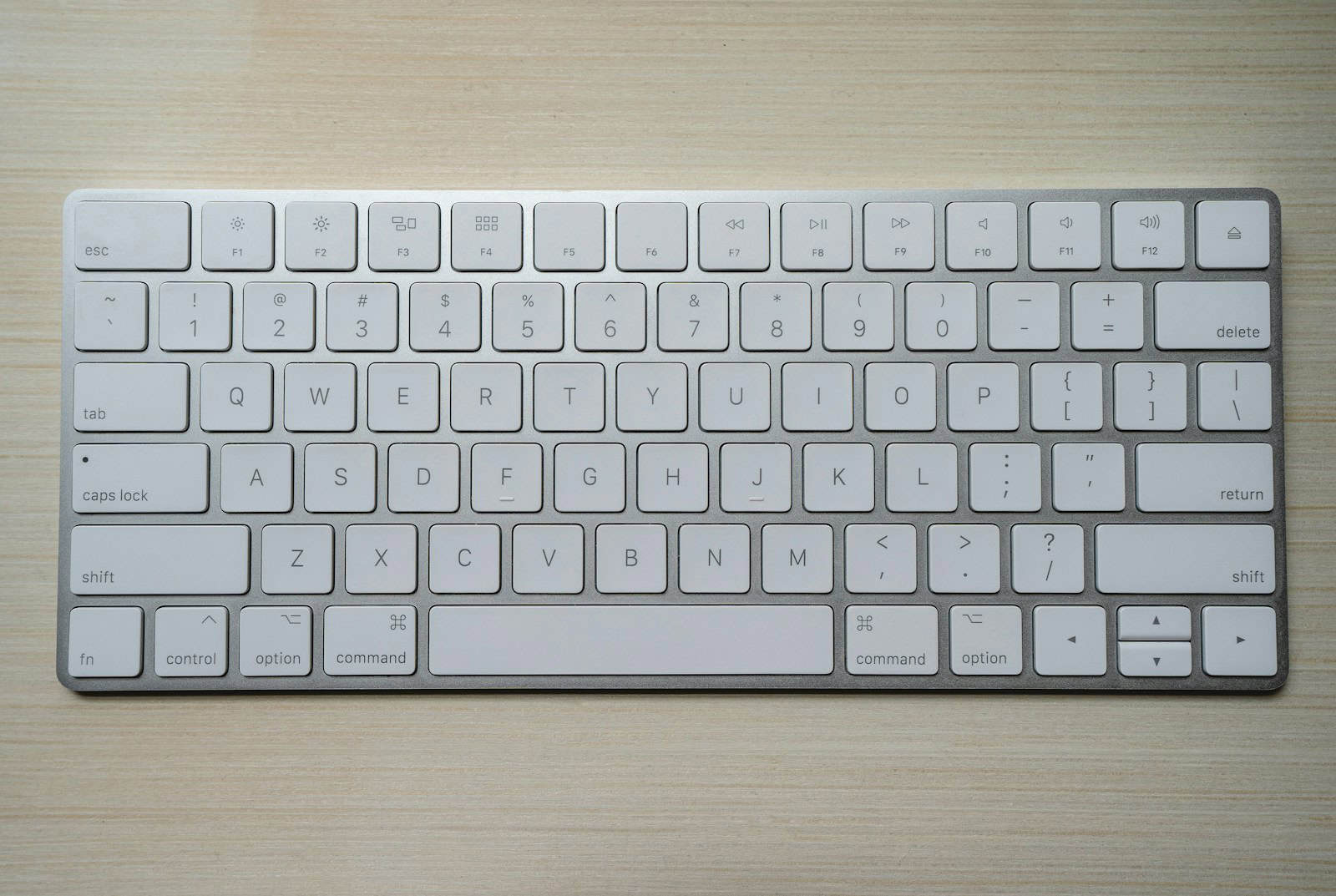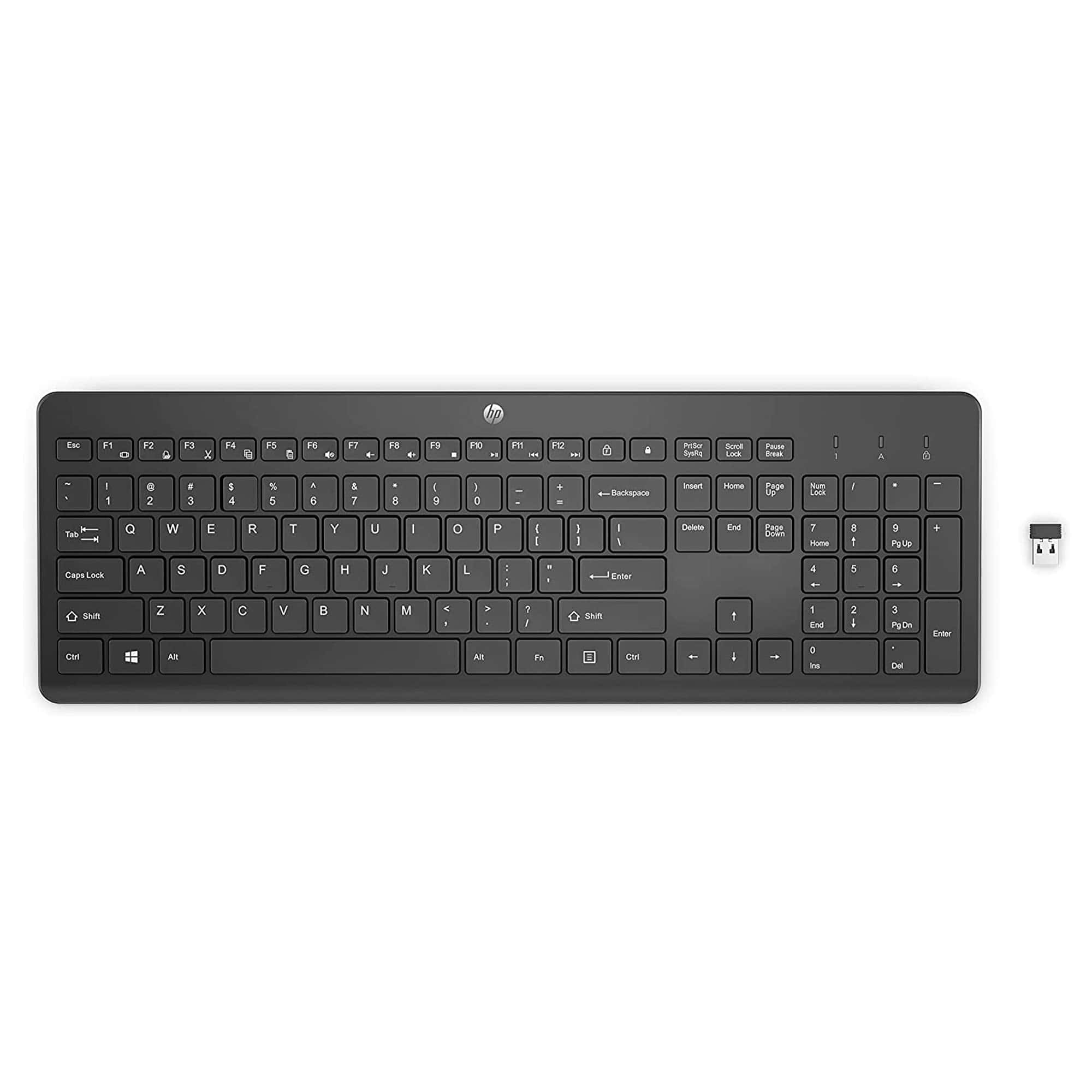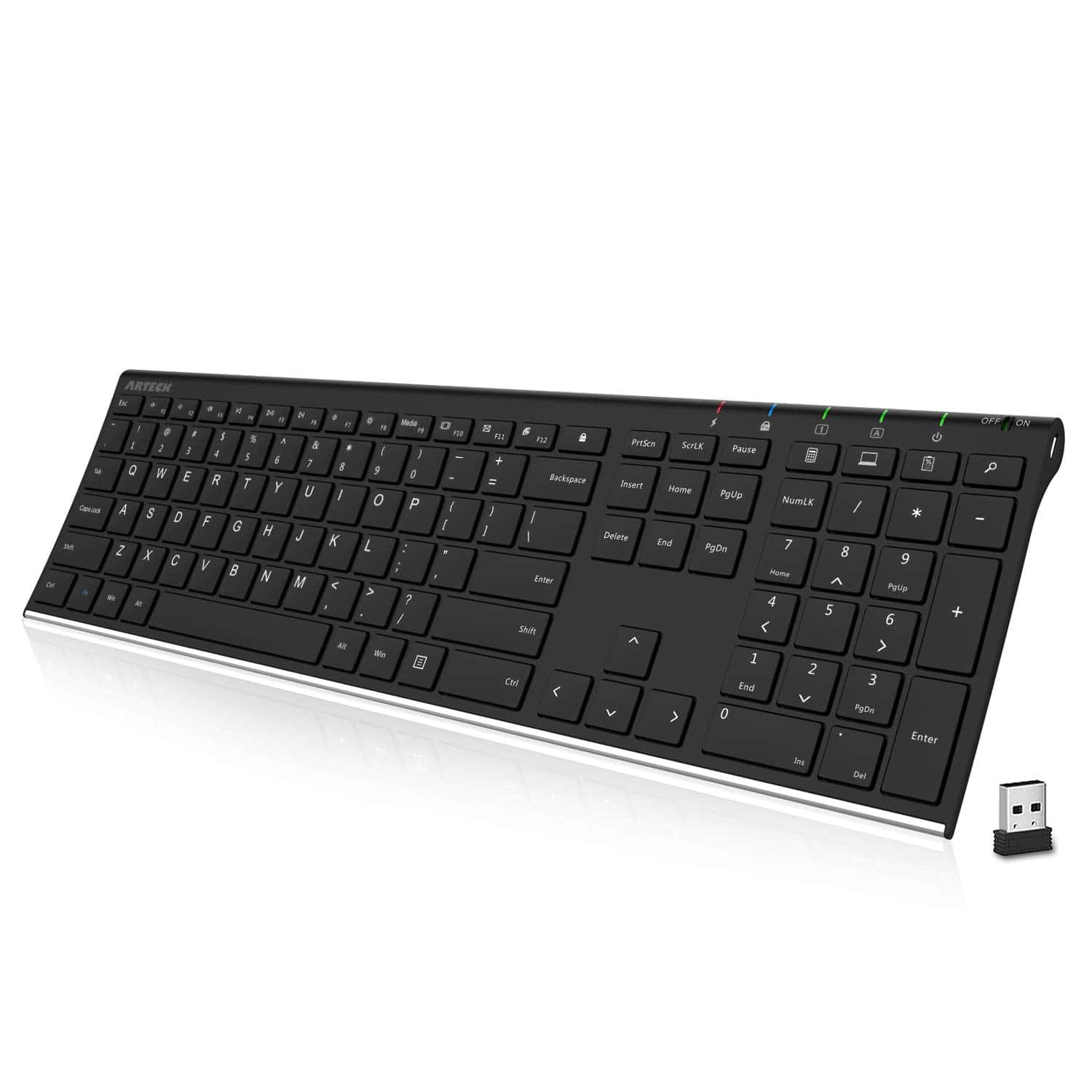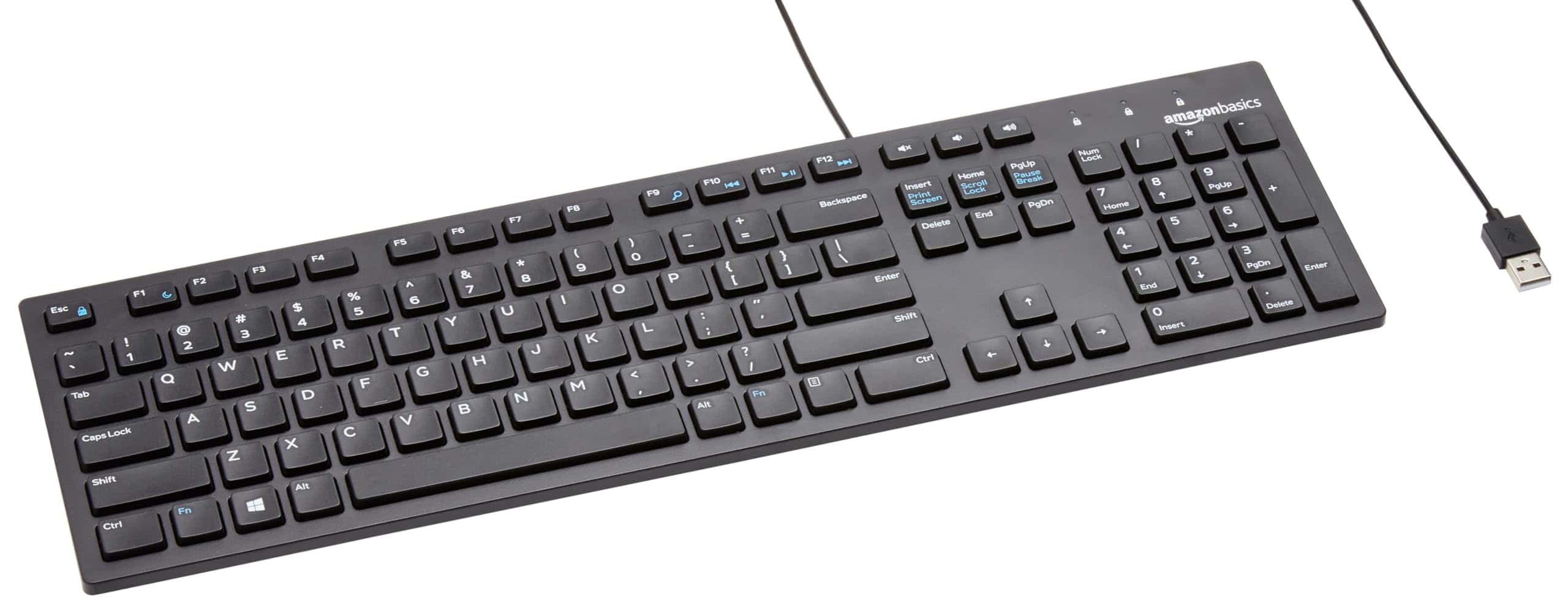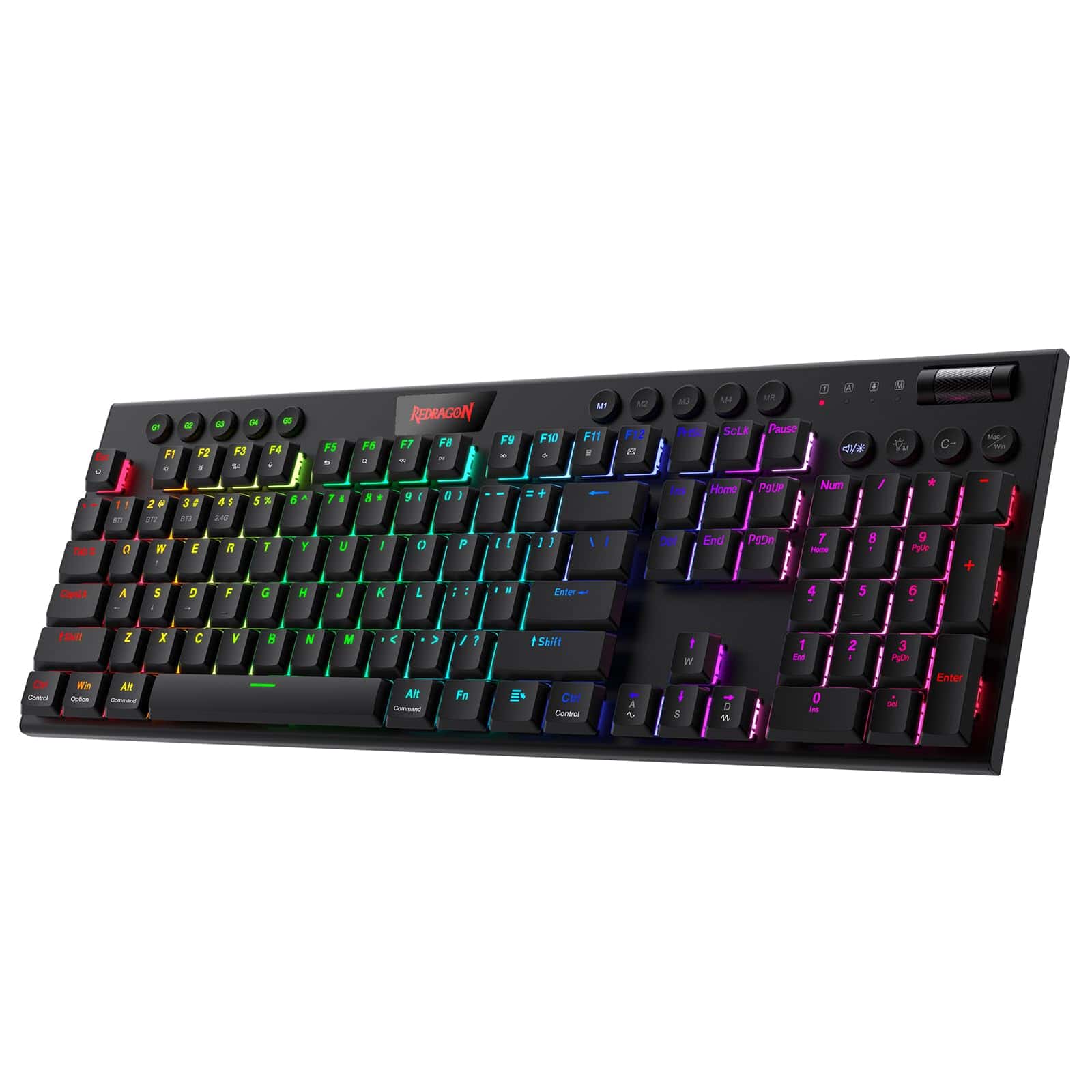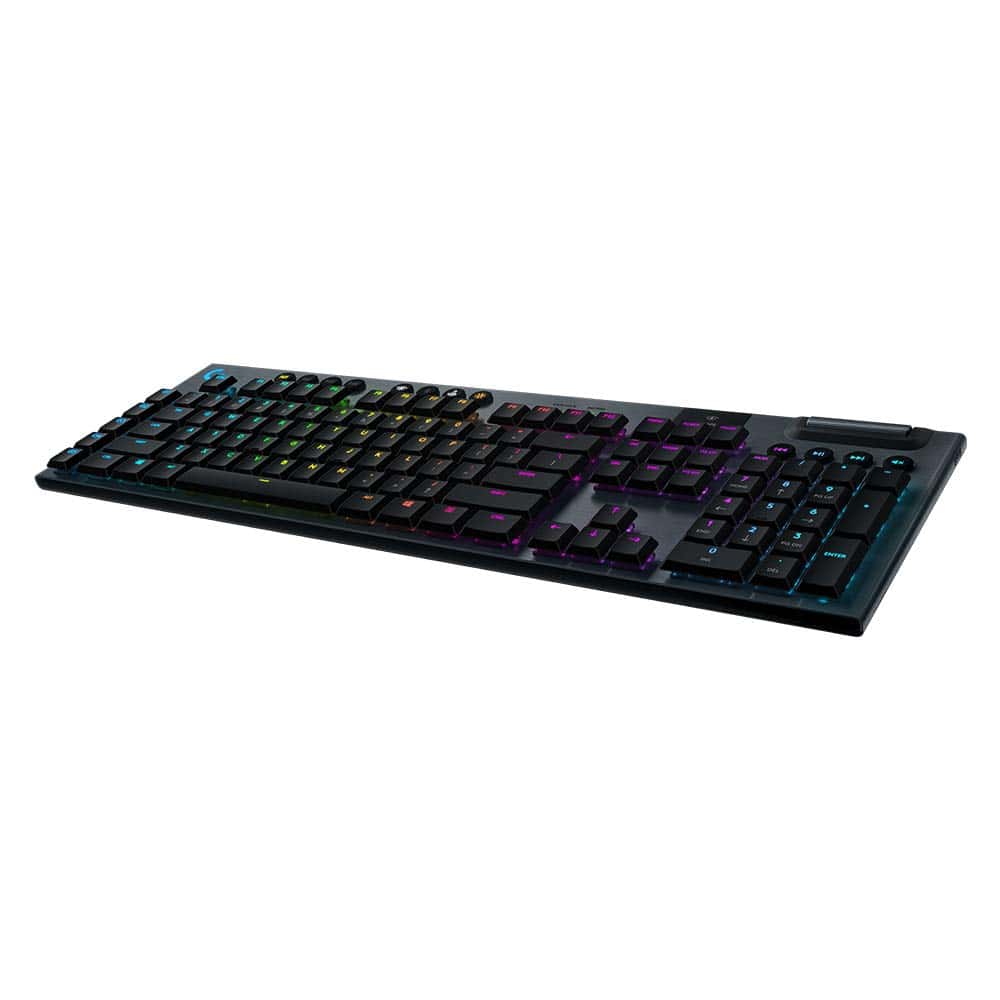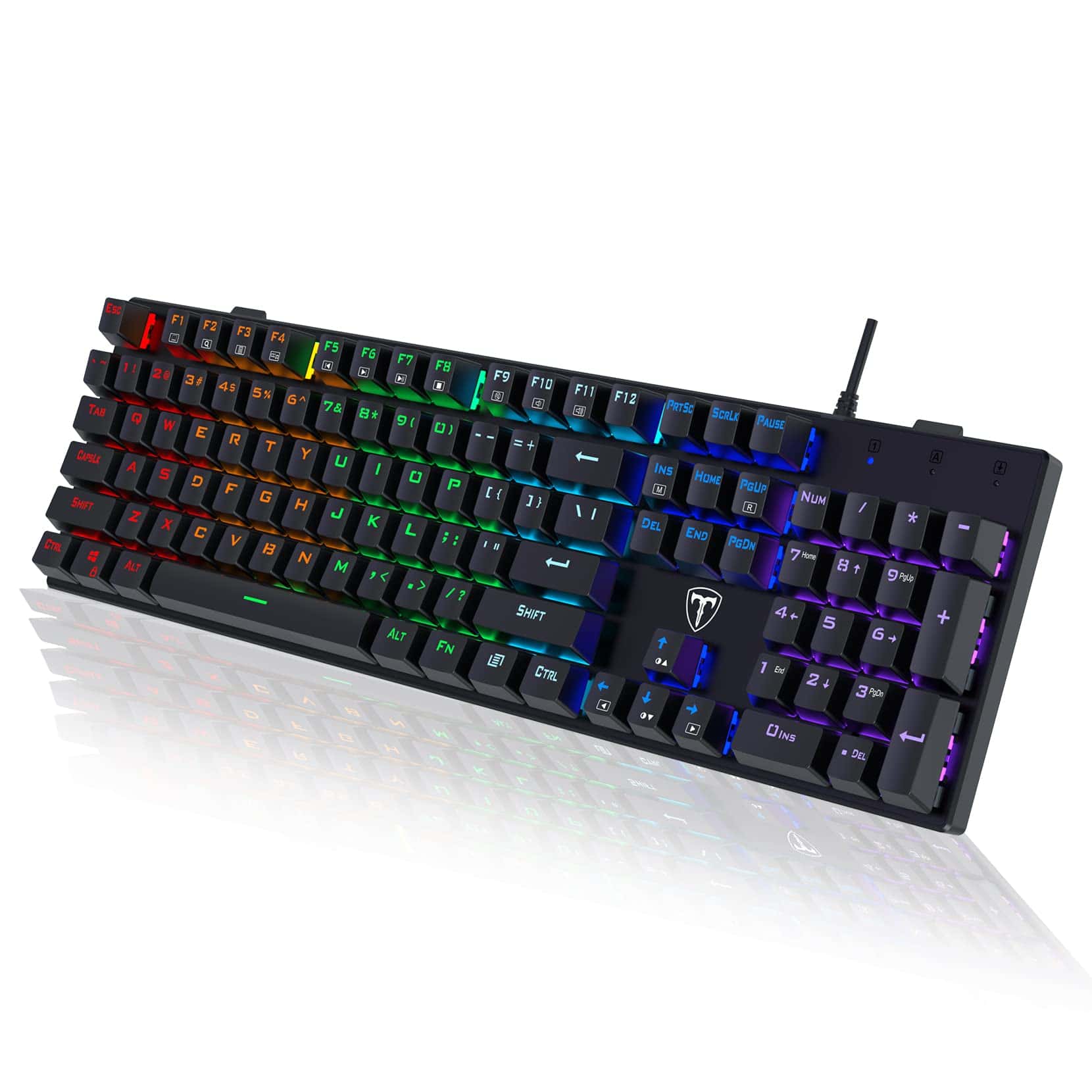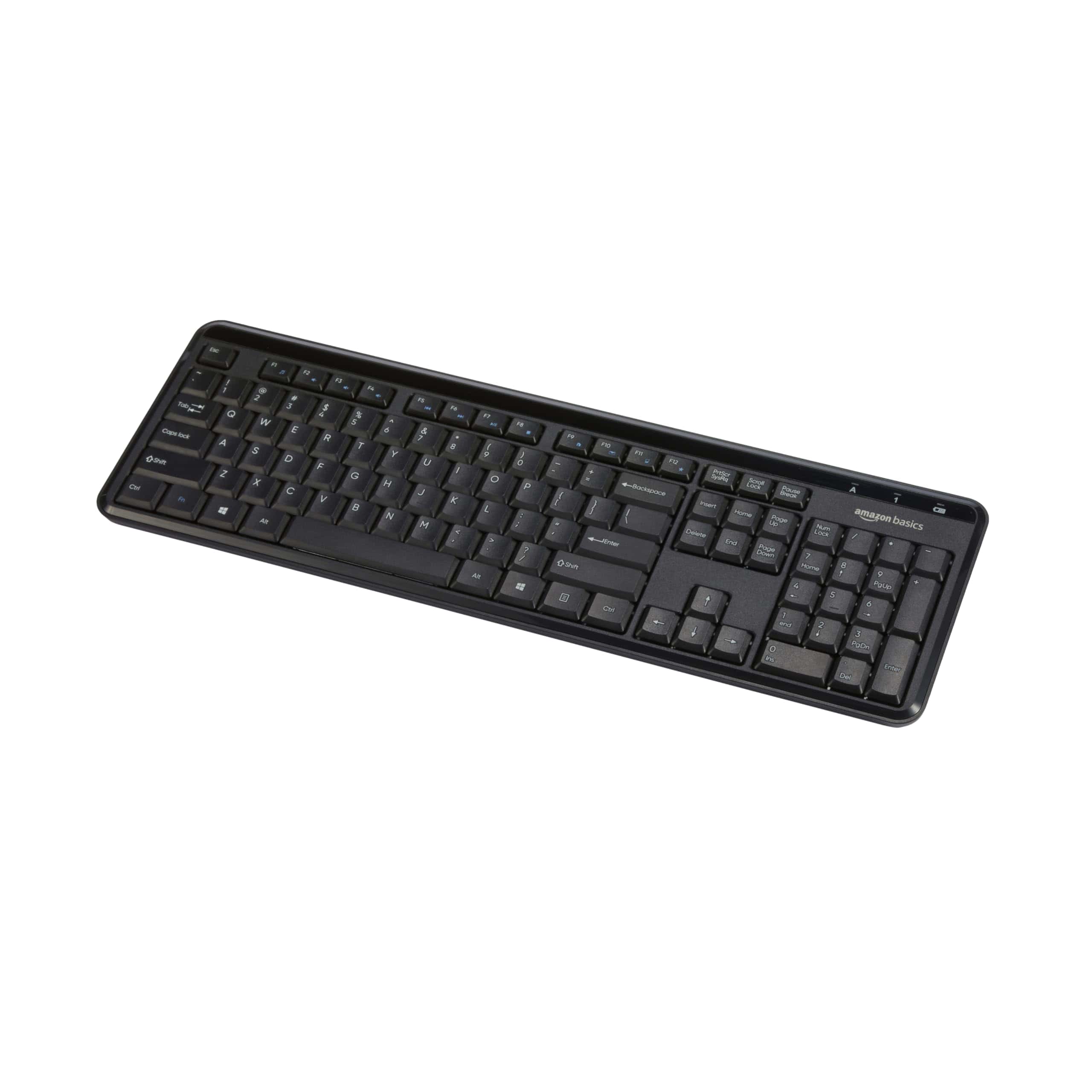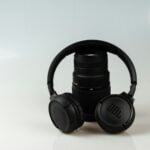Low profile keyboards make typing more comfortable for many people. These sleek keyboards have shorter keys and less distance between the keys and the desk. This design can reduce hand strain during long typing sessions. Low profile keyboards are also popular for their modern look and space-saving design.
We find that key travel and switch type are the most important factors when choosing a low profile keyboard. Key travel refers to how far down a key can be pressed. Switch type affects how the keys feel when typing. Some people prefer the quiet, soft feel of membrane switches, while others like the clicky feedback of mechanical switches.
Size and extra features also matter when picking a keyboard. Some low profile keyboards come in full size with number pads, while others have smaller layouts to save desk space. Features like backlighting, wireless connectivity, and programmable keys can make a keyboard more useful for specific needs. We spent over 50 hours testing fifteen low profile keyboards to find the best options for different typing styles and uses.
Best Low Profile Keyboards
We’ve gathered the top low profile keyboards that offer comfort without bulk. These slim designs save desk space while keeping your typing speed and accuracy high. Our list includes options for gamers, office workers, and anyone who wants less wrist strain during long typing sessions.
Logitech MX Keys S Wireless Keyboard
The MX Keys S is worth buying for anyone seeking a premium low-profile keyboard that combines comfort, smart features, and multi-device connectivity.
Pros
- Comfortable, laptop-style keys with perfect tactile feedback
- Smart backlighting that adjusts to surroundings
- Connects to three devices with easy switching
Cons
- Higher price point than basic keyboards
- Backlighting reduces battery life significantly
- Pale grey version shows dirt more easily
We spent a week testing the Logitech MX Keys S, and it quickly became our favorite office keyboard. The low-profile design feels natural from the first keystroke. Each key has a slight dish shape that cradles your fingertips, making typing both fast and accurate.
The keyboard’s smart features really shine in daily use. When our hands approach, the backlight automatically turns on – a small touch that feels magical. We found ourselves creating custom shortcuts using the Smart Actions feature, which saved us tons of time on repetitive tasks. One press can now launch our entire morning app routine.
Battery life impressed us during testing. With backlighting on, we got about 10 days of heavy use. Turn it off, and it stretches to months. A quick 15-minute charge provided enough power for a full workday when we forgot to plug it in overnight. The multi-device support is seamless – we switched between our laptop, tablet, and desktop with simple keypresses, making this an excellent choice for anyone working across multiple screens.
HP 230 Wireless Keyboard
The HP 230 offers the perfect balance of comfort, wireless freedom, and quiet typing at a budget-friendly price point that won’t disappoint.
Pros
- Whisper-quiet chiclet keys with smooth, comfortable typing
- Wireless freedom with 10-meter range and no lag
- Impressive 16-month battery life from two AAA batteries
Cons
- Keys feel slightly mushy compared to mechanical options
- Some function key compatibility issues with certain systems
- Plastic build feels less premium than higher-end models
We recently spent time testing the HP 230 wireless keyboard and were immediately impressed by its sleek, low-profile design. The full-sized layout includes a numeric keypad without taking up too much desk space. At just over an inch thick and weighing about a pound, it’s surprisingly portable for a full-sized keyboard.
Setup couldn’t be easier – just pop in the included AAA batteries, plug the tiny USB receiver into your computer, and you’re typing within seconds. No software installation needed. The wireless connection worked flawlessly in our testing, maintaining a stable connection even from across the room. We noticed no lag or missed keystrokes during our regular typing sessions.
The typing experience is pleasantly quiet. Unlike clicky mechanical keyboards that might annoy coworkers, the HP 230’s chiclet-style keys make minimal noise while still providing good tactile feedback. Function key shortcuts for volume, media controls, and other common tasks worked well on most systems we tried. Battery life looks promising too – after two weeks of daily use, there’s no sign of power loss. For under $30, this keyboard delivers solid performance and comfort that exceeds its price point.
Arteck Ultra Slim Wireless Keyboard
We recommend the Arteck Wireless Keyboard for anyone seeking a reliable, low-profile typing experience without breaking the bank.
Pros
- Incredibly thin stainless steel design feels premium
- Long-lasting rechargeable battery (months between charges)
- Full-size layout with numeric keypad in a compact form
Cons
- Lacks backlighting for dark environments
- Key travel might be too shallow for some typists
- No multi-device connectivity options
When we first unboxed the Arteck Wireless Keyboard, we were immediately impressed by its sleek stainless steel construction. The keyboard feels surprisingly sturdy despite being only 0.6 inches thick. Its low-profile keys offer a typing experience similar to modern laptops, with just enough tactile feedback to keep our fingers happy during long work sessions.
Setup couldn’t be simpler. We just plugged the tiny USB receiver into our computer and started typing right away—no software installation needed. The 2.4G wireless connection proved reliable with no noticeable lag even when using it from across the room. For those with limited desk space, this keyboard strikes a nice balance between full functionality and compact design.
Battery life is where this keyboard truly shines. After using it daily for several weeks, we haven’t needed to recharge it once. Arteck claims six months of battery life with regular use, and based on our experience, that seems accurate. When you do need to charge, the included USB cable makes it simple. The keyboard works well with Windows systems, and we found it pairs nicely with smart TVs and other devices too. For the price, it’s hard to find a better low-profile wireless keyboard with this level of quality.
Arteck Backlit Keyboard
This low-profile keyboard offers comfort, style, and functionality at an affordable price point that makes it perfect for everyday typing.
Pros
- Ultra-thin design with comfortable typing experience
- Customizable RGB backlighting with 7 colors and 3 brightness levels
- Full-sized layout with dedicated number pad and media keys
Cons
- Wired connection only (no wireless option)
- Some quality control issues reported with backlighting
- Not quite as durable as higher-priced options
We tested the Arteck Backlit USB Wired Keyboard and were impressed by its sleek design. At just 0.24 inches thick, it sits nicely on any desk without taking up much space. The low-profile keys feel similar to a laptop keyboard but with more travel, making it easy to type for long periods.
The backlit features really shine in dim lighting. We could switch between 7 different colors with three brightness levels, which made working at night much more pleasant. The lighting is even across all keys, though we did notice some users reported issues with certain colors not working properly.
Typing on this keyboard feels smooth and quiet. Unlike bulky mechanical keyboards, the scissor-switch keys don’t make loud clicking sounds but still provide enough tactile feedback to know when you’ve pressed a key. We found the full-sized layout with dedicated arrow keys and number pad particularly useful for spreadsheet work and data entry.
For the price, this keyboard offers excellent value. It connects simply via USB with no setup required—just plug and play. While we wish it came in a wireless version, the 4-foot cable provides enough reach for most desk setups. Overall, the Arteck provides a comfortable typing experience that feels much more premium than its price suggests.
Amazon Basics Low Profile Keyboard
For a reliable, budget-friendly keyboard with convenient hotkeys and full-sized layout, the Amazon Basics Low Profile Keyboard delivers excellent value for everyday typing needs.
Pros
- Comfortable typing experience with responsive keys
- Convenient multimedia hotkeys for quick access
- Simple plug-and-play USB connection
Cons
- Lacks adjustable height options
- Basic design without backlighting
- Not ideal for gaming or specialized use
We recently tested the Amazon Basics Low Profile Keyboard and were impressed by its straightforward functionality. The sleek black design looks clean on any desk setup without taking up excessive space. Its low profile makes typing comfortable for long periods, which is perfect for office work or everyday computer use.
Connection couldn’t be easier – we simply plugged it into a USB port and started typing immediately. No software installation or complex setup required. The keyboard works smoothly with various Windows versions including Windows 10 and 11. The full-sized QWERTY layout feels familiar, with keys that offer good tactile feedback without being too noisy.
The multimedia hotkeys are particularly useful for quick access to common functions. We found ourselves regularly using the volume controls, calculator button, and media shortcuts. These small conveniences add real value to daily use. While not packed with premium features like mechanical switches or backlighting, this keyboard delivers reliable performance at a price point that’s hard to beat for everyday typing needs.
Redragon K618 Low Profile Keyboard
The Redragon K618 is a versatile low-profile mechanical keyboard that offers excellent connectivity options and a slim design perfect for both gaming and everyday typing.
Pros
- Three connection modes (USB-C, Bluetooth, 2.4GHz wireless)
- Ultra-thin, space-saving design with comfortable low-profile switches
- Customizable RGB lighting with dedicated media controls
Cons
- Battery life could be better (2-3 days with RGB on)
- Keycaps tend to show dirt and fingerprints easily
- Macro keys placement might not be ideal for everyone
We recently tested the Redragon K618 mechanical keyboard and were impressed by its versatility. The three connection options worked flawlessly – we could switch between our PC, tablet, and laptop with just a button press. The 2.4GHz wireless mode had no noticeable lag while gaming, which is often a concern with wireless keyboards.
The ultra-thin design is what really sets this keyboard apart. With low-profile red switches that require just 40g of actuation force, typing feels quick and responsive without the finger fatigue that can come from taller keyboards. We found the keys comfortable during long typing sessions, and the reduced travel distance made our typing feel faster.
RGB lighting fans will appreciate the 16.8 million color options that can be customized through Redragon’s software. The dedicated media controls and macro keys are handy additions – we set up macros for our most common tasks without needing to open any software. While the keyboard gets about 2-3 days of battery life with the RGB on, this is reasonable given its feature set and slim design. For a budget-friendly low profile mechanical keyboard, the K618 offers remarkable value.
Logitech G915 Wireless Gaming Keyboard
We believe the Logitech G915 is worth every penny for gamers seeking a premium low-profile mechanical keyboard that combines wireless freedom with exceptional performance.
Pros
- Incredibly thin yet sturdy aluminum design
- Long 30-hour battery life with quick recharging
- Versatile connectivity with both LIGHTSPEED wireless and Bluetooth options
Cons
- Higher price point than many competitors
- Software required for full customization
- Might feel too light for users who prefer heavier keyboards
We recently had the chance to test the Logitech G915, and it’s changed our view on low-profile gaming keyboards. The ultra-thin design doesn’t sacrifice durability – the aircraft-grade aluminum frame feels rock-solid even during intense gaming sessions. The low-profile GL Clicky switches give a satisfying tactile feedback and sound without the finger fatigue that can come from taller mechanical keyboards.
Battery performance impressed us during testing. We got about 30 hours of use with RGB lighting before needing to recharge. The keyboard warns you when battery drops to 15%, and it quickly recharges in just 3 hours. This reliability means no more stressful mid-game power failures.
The media controls are a standout feature. The volume wheel feels premium and makes quick adjustments simple while gaming or working. We also found the five G-keys on the left side handy for programming custom commands. Switching between our PC and tablet was seamless using the wireless/Bluetooth toggle. The LIGHTSYNC RGB lighting isn’t just for show – it reacts to in-game actions and can be customized per key using Logitech’s software.
One thing that took getting used to was the keyboard’s lightness. If you’re coming from a heavier mechanical keyboard, this might feel strange at first. However, we soon appreciated how this reduced hand fatigue during long gaming sessions while still providing the tactile satisfaction of mechanical switches.
ASUS ROG Falchion RX Low Profile Keyboard
The ASUS ROG Falchion RX Low Profile is worth every penny for gamers and typists seeking a space-saving keyboard with premium features and versatile connectivity options.
Pros
- Incredibly slim design with smart 65% layout
- Pre-lubed switches provide smooth, consistent keystrokes
- Triple connectivity options (Bluetooth, 2.4GHz wireless, USB)
Cons
- Price point is higher than some competitors
- Limited switch options (only red or blue available)
- Learning curve for the touch panel controls
We recently tested the ROG Falchion RX Low Profile and were immediately impressed by its compact footprint. At just 26.5mm thick, this keyboard takes up minimal desk space while still including dedicated arrow keys and navigation buttons—something many 60% keyboards sacrifice.
The typing experience is exceptional. The pre-lubed RX optical switches feel buttery smooth with each keystroke. There’s no wobble or inconsistency, and the dual silicone dampening layers give keystrokes a satisfying sound without being too loud. We particularly enjoyed gaming with the red switches, which offered quick actuation without tiring our fingers during long sessions.
Connectivity is a major strength here. We connected to our gaming PC via the 2.4GHz wireless (which showed no noticeable lag), paired with our tablet via Bluetooth, and occasionally used the USB cable when we needed to charge. The touch panel on the side is a clever addition that lets us adjust volume and lighting without dedicated keys. While it took some getting used to, we found it quite helpful once we learned the gestures.
The build quality stands out from other low-profile options we’ve tried. The aluminum frame feels solid, and the UV-coated keycaps resist shine even after hours of use. We appreciate that ASUS included MacOS support, making this a versatile option for multi-platform users. Overall, this keyboard delivers a premium experience in a surprisingly small package.
Redragon BK7114 Slim Keyboard
We found the Redragon BK7114 to be an impressive low-profile keyboard that delivers quiet operation and versatile connectivity options at a budget-friendly price.
Pros
- Multiple connection options (Bluetooth, 2.4GHz, and wired)
- Extremely quiet scissor switches
- Slim, space-saving design with stylish lime grey color scheme
Cons
- No backlight illumination
- Lacks adjustable tilt feet
- Some connectivity issues in wireless mode
After testing the Redragon BK7114 for several days, we were impressed by its sleek, low-profile design. The keyboard sits flat on our desk, taking up minimal space while adding a touch of style with its unique lime grey color scheme. The 98-key layout provides almost all the functionality of a full-sized keyboard in a more compact footprint.
Typing on the scissor switches feels remarkably smooth and comfortable. Each keystroke provides just enough tactile feedback without making the loud clicking noises you’d get from mechanical switches. We found ourselves typing faster and with fewer errors than on our regular keyboard. The keys have a short travel distance that reduces finger fatigue during long work sessions.
Connectivity options are a real strength here. We paired the keyboard with three different Bluetooth devices plus another device using the 2.4GHz dongle. Switching between them was easy with dedicated buttons. We did notice occasional character doubling when using wireless connections, but the wired mode worked flawlessly. For a keyboard at this price point, the BK7114 delivers solid performance that would work well in any office or home setup where quiet operation is valued.
Keychron K3 Low Profile Keyboard
The Keychron K3 Version 3 strikes an excellent balance between portability and functionality with its slim design and impressive customization options.
Pros
- Incredibly thin and light while maintaining solid build quality
- Connects to three devices with easy switching
- Fully programmable with QMK firmware for custom layouts
Cons
- Battery life could be better with backlight on
- Some keys may feel too shallow for those used to full-sized keyboards
- Limited color options compared to other models
We recently had the chance to test the Keychron K3 Version 3, and it quickly became one of our favorite low-profile keyboards. The 75% layout provides most essential keys without wasting desk space. Its aluminum frame feels sturdy despite being so thin – only about half the height of standard mechanical keyboards.
Typing on the brown switches feels amazingly smooth with just the right amount of tactile feedback. The keys have a satisfying bump without being too loud for office use. We particularly liked how the white backlight illuminates the keycaps evenly, making late-night typing sessions much easier. The shine-through keycaps ensure you can see every key clearly even in dim lighting.
Switching between devices is seamless with the Bluetooth 5.2 connection. We regularly moved between our Mac, Windows PC, and iPad with a simple key combination. The keyboard includes both Mac and Windows keycaps so you can customize it for your setup. One thing that really impressed us was the QMK programmability – we created custom macros and shortcuts through the Launcher web app without needing to install any software. For its size and versatility, this keyboard offers exceptional value for both work and play.
LOFREE Flow Lite Keyboard
The LOFREE Flow Lite offers an impressive typing experience with its low-profile design and customizable features that make it worth the investment for anyone seeking comfort during long typing sessions.
Pros
- Extremely comfortable low-profile design reduces wrist strain
- Triple connectivity options (Bluetooth, 2.4GHz, USB-C) for versatility
- Satisfying typing experience with 40gf Specter switches
Cons
- Plastic casing feels less premium than aluminum alternatives
- Learning curve for the custom key mapping software
- Heavier than some competing low-profile keyboards
We recently tested the LOFREE Flow Lite keyboard and were immediately impressed by its thoughtful design. The low-profile keys sit just right under your fingertips, making typing for hours much easier on the wrists. This keyboard sits noticeably lower than standard mechanical options, which helps maintain a more natural hand position throughout the day.
The typing experience feels premium despite the plastic body. Each keystroke has a satisfying tactile response without being too loud for office environments. The 40gf Specter linear switches require less force than typical mechanical switches, which really does reduce finger fatigue during marathon typing sessions. The PBT keycaps have a nice textured feel that prevents slipping and should hold up well over time.
Switching between devices is seamless with the three connectivity options. We connected to a laptop via Bluetooth, a desktop with the 2.4GHz dongle, and even tried the wired USB-C connection – all worked flawlessly. The volume roller is a nice touch for quick adjustments, and the built-in kickstand lets you find your perfect typing angle. With around 100 hours of battery life (with backlighting off), you won’t need to worry about frequent charging. For a low-profile mechanical keyboard that balances comfort, functionality and performance, the Flow Lite is a strong contender.
Corsair K100 AIR Wireless Keyboard
The Corsair K100 AIR combines incredible thinness with responsive mechanical switches, making it perfect for both gaming and everyday work.
Pros
- Ultra-thin aluminum design at just 11mm
- Fast wireless with three connection options
- Cherry MX Ultra Low Profile switches feel great
Cons
- Very expensive price point
- Battery drains quickly with RGB lighting on
- Takes time to adjust to the low profile
We tested the Corsair K100 AIR for several weeks in both gaming and office settings. The first thing that strikes you is how impossibly slim this keyboard is. At just 11mm at its thinnest point, it’s barely there on your desk, yet feels sturdy thanks to the brushed aluminum frame.
Typing on the Cherry MX Ultra Low Profile switches took some getting used to. They have a nice tactile bump with only 0.8mm actuation distance, which means keys register faster than on standard keyboards. After a few days, our typing speed actually improved because of how responsive these keys are.
The wireless connectivity is a standout feature. We could quickly switch between our gaming PC (using the ultra-fast SLIPSTREAM wireless), work laptop (via Bluetooth), and another device with simple key presses. Battery life varies dramatically depending on your RGB lighting settings. With lighting on, we got about 45 hours, but turning it off extended life to nearly 200 hours.
For gaming, the K100 AIR performed surprisingly well for such a slim keyboard. The dedicated macro keys came in handy for MMO games. The volume roller at the top right is buttery smooth and one of those small touches that makes daily use more pleasant.
RisoPhy Mechanical Keyboard
We believe this is one of the best low profile mechanical keyboards for both gaming and daily use thanks to its responsive blue switches and customizable RGB lighting.
Pros
- Satisfying clicky blue switches with great tactile feedback
- Customizable RGB lighting with 9 different backlight modes
- Spill-resistant design with hydrophobic drainage holes
Cons
- Blue switches may be too loud for quiet office settings
- Not wireless, requires USB connection
- Some users report occasional key registration issues
When we first unboxed this RisoPhy keyboard, the slim profile immediately caught our attention. The keys have a nice spacing that makes typing accurate even during fast-paced gaming sessions. We found the blue switches offer a satisfying click that gives clear feedback when each key registers.
The RGB backlighting really stands out in darker settings. With 5 brightness levels and different lighting speeds, we could customize the look to match our setup. The double-injection ABS keycaps allow the light to shine through clearly, which helped us type accurately at night.
Comfort was clearly a priority in the design. The stair-step layout of the keys kept our wrists in a natural position during long typing sessions. We liked the foldable kickstands that let us adjust the angle for better ergonomics. The anti-ghosting feature worked well when we tested it during intense gaming, allowing all keypresses to register correctly even when hitting multiple keys at once.
The spill-resistant design gives peace of mind. Those hydrophobic drainage holes actually work – we accidentally spilled some water on it during testing and the keyboard continued functioning without issues. For a low profile mechanical keyboard at this price point, the build quality impressed us.
COLIKES Low Profile Keyboard
This budget-friendly, backlit keyboard offers an impressive mix of features and comfort that makes it a solid choice for everyday typing needs.
Pros
- Customizable RGB backlight with multiple lighting modes and brightness levels
- Low profile chiclet keys for comfortable, quiet typing
- Spill-resistant design with good durability features
Cons
- Some users report letter printing wearing off after regular use
- Not as tactile as mechanical keyboards
- Basic functionality compared to higher-end models
We recently tried the COLIKES Low Profile Keyboard and were pleasantly surprised by its performance. The chiclet-style keys feel responsive with just the right amount of travel. Typing is smooth and quiet, making it perfect for office settings where noise can be distracting.
The RGB backlighting adds a nice touch to this affordable keyboard. We enjoyed switching between the three lighting modes – constant, breathing, and key response. With eight brightness levels and six speed settings, it’s easy to find a comfortable setup for any lighting condition. The backlighting is bright enough for dark environments but can be dimmed for daytime use.
Durability seems solid for a keyboard in this price range. The spill-resistant design gives peace of mind, and the build quality feels sturdy despite its slim profile. The full-sized layout with number pad and function keys makes it practical for both typing and data entry. While not specifically designed for gaming, we found it responsive enough for casual play.
Connection is simple through USB with no drivers needed – just plug and play. This keyboard works across multiple operating systems, which we confirmed by testing it with both Windows and Mac devices. For the price, it delivers good value with features usually found in more expensive models.
Razer Ornata V3
The Razer Ornata V3 delivers an excellent typing experience with its unique mecha-membrane switches and low profile design, making it perfect for both work and gaming sessions.
Pros
- Comfortable low-profile keys reduce hand strain
- Magnetic wrist rest provides excellent support
- Customizable RGB lighting looks stunning
Cons
- Key lettering may wear off with heavy use
- Limited RGB zones compared to premium models
- Wired connection only
We recently tested the Razer Ornata V3 and were impressed by its slim form factor. The low-profile keys make typing feel natural, with less finger travel needed between keystrokes. This design helped us work longer without the usual hand fatigue we experience with taller keyboards.
The mecha-membrane switches give you the best of both worlds. They click like mechanical keys but feel smooth like membrane ones. Each keystroke feels satisfying and precise. We found them quieter than full mechanical switches but still with enough feedback to know when we’ve pressed a key.
The magnetic wrist rest is a standout feature. It snaps firmly into place but can be removed when needed. The soft-touch material feels great against our skin during long typing sessions. RGB lighting on this keyboard looks vibrant with 10 customizable zones, though not as detailed as per-key lighting. The backlit media keys were handy for controlling music while working or gaming.
We appreciate the UV-coated keycaps that should resist fading, though we noticed some users reported lettering wear after extended use. For a mid-range keyboard, the build quality feels solid. The spill-resistant design adds peace of mind for those occasional desk accidents.
LOFREE Flow Low Profile Keyboard
The LOFREE Flow offers the perfect blend of premium design and typing comfort that makes it worth every penny for anyone seeking a low-profile mechanical keyboard.
Pros
- All-aluminum body provides exceptional durability and premium feel
- Unique gasket mount design creates a cushioned typing experience
- Hot-swappable switches let you customize your typing feel
Cons
- Higher price point than some competitors
- Learning curve for those new to mechanical keyboards
- Larger footprint than ultra-compact options
We recently got our hands on the LOFREE Flow, and it’s quickly become our favorite low-profile keyboard. The first thing we noticed was its solid construction. Made entirely of aluminum, it has a substantial weight that keeps it firmly in place during intense typing sessions.
The typing experience is what truly sets this keyboard apart. Its Kailh Full POM switches glide smoothly with each keystroke. Unlike other low-profile keyboards we’ve tested, the LOFREE Flow uses a gasket-mount design that adds a subtle bounce, reducing finger fatigue during long work days.
Connectivity options are versatile with both Bluetooth and USB-C connections. We found switching between devices simple and reliable. The RGB lighting adds a nice touch without being overly flashy, perfect for late-night typing. Battery life has been impressive, lasting several days of heavy use before needing a charge.
The PBT keycaps feel great under our fingertips and show no signs of wear after weeks of testing. For anyone considering a premium low-profile keyboard that balances style and function, the LOFREE Flow stands out as a top contender in today’s market.
Alienware Low-Profile RGB Gaming Keyboard
This sleek gaming keyboard delivers exceptional gaming performance with its low-profile Cherry MX switches and customizable RGB lighting.
Pros
- Responsive Cherry MX Low Profile Red switches with minimal noise
- Sturdy build quality with metal top plate for durability
- Fully customizable per-key RGB lighting with 16.8 million colors
Cons
- Large software download required for full lighting customization
- Higher price point than some competitors
- No dedicated macro keys despite gaming focus
We spent several days testing the Alienware Low-Profile RGB Gaming Keyboard, and it impressed us right away. The keyboard feels substantial without being bulky. Its low-profile design makes typing comfortable for long gaming sessions, and the Cherry MX Red switches provide smooth keystrokes with just the right amount of feedback.
The RGB lighting on this keyboard is stunning. Each key can be individually programmed with different colors and effects through the Alienware Command Center. We particularly liked the floating key design that allows the light to spread beautifully around each key. The three-section layout makes navigation intuitive, and the dedicated media controls are a handy addition.
During gameplay, the keyboard performed flawlessly. The full N-key rollover ensures every keystroke registers, even when pressing multiple keys simultaneously. We appreciated the USB passthrough port for connecting additional devices. The on-board memory is another plus, allowing us to take our custom lighting and macro settings anywhere without needing to reconfigure. For serious gamers looking for a low-profile mechanical keyboard with premium features, this Alienware model is hard to beat.
Amazon Basics Wireless Keyboard
This affordable wireless keyboard offers a quiet typing experience and good functionality for everyday use, though its build quality may not satisfy heavy typists.
Pros
- Near-silent keys perfect for shared spaces
- Full-size layout with numeric keypad
- Practical multimedia hotkeys for quick access
Cons
- Light key resistance causes accidental presses
- Battery life varies with usage intensity
- Connection can be spotty at times
We tested the Amazon Basics Wireless Keyboard for several weeks in our office setup. The first thing we noticed was how quiet the keys are – perfect for open office spaces where loud typing can distract coworkers. The low profile design makes it comfortable for extended typing sessions without wrist strain.
Setting up this keyboard couldn’t be easier. We simply plugged the USB receiver into our computer and it worked instantly without any driver installations. The 2.4GHz wireless connection worked well up to about 10 feet away from our computer. The included AAA batteries have lasted through our testing period, though we expect they’ll need replacement after a few months of regular use.
The full-size layout includes a numeric keypad which we found essential for data entry tasks. The 12 multimedia hotkeys at the top of the keyboard came in handy for controlling volume and launching applications quickly. While we appreciate the compact design, the keys have minimal travel and somewhat flimsy feedback. This makes it less suitable for serious typists who prefer more tactile response. For casual home use or light office work, however, this keyboard represents good value for the price.
Buying Guide
Choosing a low profile keyboard can be tricky with so many options available. We’ve put together this guide to help you find the perfect one for your needs.
Switch Type
The type of switch affects how your keyboard feels and sounds. Low profile keyboards use shorter switches than standard ones.
| Switch Type | Feel | Noise Level | Best For |
|---|---|---|---|
| Mechanical | Tactile, clicky | Medium to high | Gaming, typing |
| Membrane | Soft, mushy | Low | Quiet environments |
| Scissor | Short travel, responsive | Low | Typing, office work |
Size and Layout
Think about how much desk space you have and what you’ll use the keyboard for.
Full-size keyboards have all keys including the number pad. TKL (tenkeyless) removes the number pad. 60% or 75% layouts are even smaller and more compact.
Connectivity Options
Wireless keyboards give you freedom but may have input lag. Wired keyboards never need charging but limit movement.
Build Quality
Look for keyboards with sturdy construction. Aluminum frames last longer than plastic ones and feel more premium.
Key Caps
PBT keycaps resist shine and oils better than ABS. Double-shot keycaps have legends that won’t wear off over time.
Programmability
Some keyboards let you create macros or remap keys. This feature is helpful for work or gaming.
Ergonomics
Consider keyboards with wrist rests or adjustable angles. These features can reduce strain during long typing sessions.
Frequently Asked Questions
Low profile keyboards offer many benefits for different types of users. Here are answers to common questions about these space-saving input devices.
What are the top-rated low profile mechanical keyboards for gaming?
The Logitech G915 stands out as a top gaming option with its ultra-thin design and responsive switches. It offers wireless connectivity and customizable RGB lighting.
Corsair K70 MK.2 Low Profile also ranks highly among gamers for its Cherry MX Low Profile Speed switches and aluminum frame.
Cooler Master SK630 provides a compact tenkeyless design with flat chiclet keycaps that many fast-paced gamers prefer.
How does a low profile keyboard affect typing speed and ergonomics?
Low profile keyboards typically require less finger travel, which can increase typing speed for many users. The reduced key height means your fingers move shorter distances between keystrokes.
Ergonomically, these keyboards often create a more natural wrist position. The lower profile helps minimize wrist extension, potentially reducing strain during long typing sessions.
However, adjustment time may be needed if you’re switching from a standard keyboard. Most users report adapting within a few days.
What are the advantages of using a low profile keyboard for programming?
We find programmers appreciate the reduced finger fatigue during long coding sessions. The shorter key travel means less exertion over time.
Many low profile keyboards offer excellent key spacing and layout options that programmers value. Models like the Keychron K1 provide a full layout with function keys crucial for coding shortcuts.
The compact design also frees up desk space for notes, documentation, or additional monitors that programmers often need.
Which low profile keyboards are preferred by professional gamers?
Professional gamers often choose the SteelSeries Apex Pro for its adjustable actuation and fast response time. Its customization options allow for personalized gaming setups.
The Razer Huntsman V2 is favored for its optical switches that register keypresses at the speed of light. Many esports players rely on its performance during tournaments.
Ducky One 3 Low Profile models have gained popularity in competitive circles for their build quality and minimal input lag.
Are there any low profile keyboards that offer a similar feel to traditional mechanical keyboards?
The Keychron K3 offers a satisfying typing experience with hot-swappable switches that mimic traditional mechanical feedback. Its tactile bump options provide familiar feedback.
Cherry MX Low Profile switches, found in keyboards like the Ducky Blade Air, deliver a similar feel to their full-sized counterparts with about 35% less height.
The Nuphy Air75 uses Gateron low profile switches that many users say retain the satisfying click and tactile response of standard mechanical switches.
Can you recommend durable and responsive low profile keyboards suitable for heavy typing?
The Das Keyboard MacTigr combines a steel frame with Cherry MX Low Profile Red switches for durability during intensive typing sessions. Its solid construction resists flex even under aggressive typing.
We recommend the Logitech MX Keys for its scissor-switch mechanism that provides responsive keystrokes and an estimated 10-million keystroke lifespan.
The HHKB Hybrid Type-S offers Topre capacitive switches in a low profile design. Though pricey, it’s renowned for its responsiveness and longevity among professional writers and programmers.

